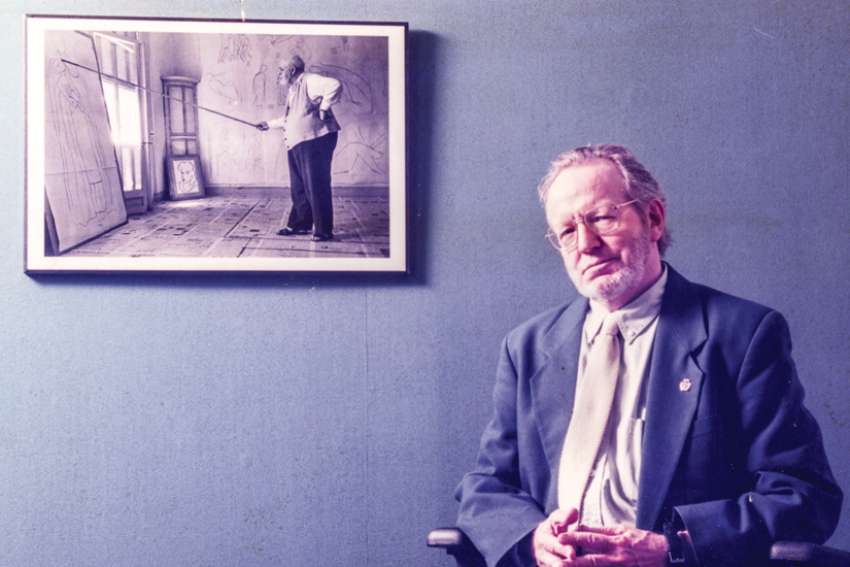He was to take the part of grandfather in a youthful experiment in simple living, building a community of service and re-imagining faith in a secular city.
Already by then, the distinguished professor of art history had joined with other Jesuits in befriending people dying of AIDS. This was years before HIV was a manageable disease, when a positive test was a death sentence. He made friends with these people and was at their bedside when they died.
Throughout his 70s and 80s, Fr. Larisey was an example to younger Jesuits of how to live as a faithful Christian in the spirit of St. Ignatius of Loyola — without fear, without anger, without attachments and with gratitude.
On April 30, at 91, Fr. Larisey, 68 years a Jesuit and 55 a priest, died at St. Michael’s Hospital in Toronto of COVID-19. Among his last words were, “I am happy. I am feeling better and I am looking forward to some good conversation with you,” reported his Jesuit brothers from the Rene Goupil infirmary in Pickering, Ont., where three other Jesuit priests also died from the virus.
Fr. Larisey was born in Halifax on March 30, 1929, growing up in the Great Depression. After three years at Saint Mary’s University in Halifax, he joined the Jesuits in 1952. His whole life he had been attracted to art and he wanted to study it in a serious way. So, beginning in 1959, each year he would ask his superior if he could study art. Each year he was told “No.”
“One of the good things about Jesuit superiors is that they have terms,” Fr. Larisey told The Catholic Register in 2011 as Regis College launched its annual Peter Larisey Lecture in art and faith.
In 1966, Fr. Larisey handed a new provincial superior a scrapbook filled with his published writing about art, and newspaper reviews of exhibitions he had mounted at Toronto’s Regis College.
“He (the provincial superior) carried the scrapbook in his hands and said, ‘You take this as far as you can,’ ” Larisey recalled.
He took it to New York’s Columbia University where he studied art history, earning a PhD in 1982, when he was already teaching the subject at Ottawa’s Carleton University.
Fr. Erik Oland, provincial of the Jesuits of Canada, remembers taking Fr. Larisey’s course in “Art and Christianity” when studying at Regis College in the early 2000s. He said it “was just like having a nice bottle of wine every week.”
At long dinners, Fr. Larisey and Oland would discuss art and history and the hopes and challenges of the Church. Fr. Larisey was one of the Jesuits after the Great Council of 1962 to 1965 who cut a path back to the renaissance roots of the order as 17th-century champions of art, culture and civilization.
“Absolutely a pioneer. So things started to open up and Peter was primed,” Oland said. “He just was primed to take the lead.”
Fr. Larisey’s sense of calling to intellectual and religious life was bolstered by one of the great Jesuit minds of the 20th century, Fr. Bernard Lonergan. He was a good friend and ally of a young Peter Larisey, said Jesuit Fr. Bob Doran.
“Frankly, I think he (Fr. Larisey) needed that kind of encouragement, and to get it from somebody with as large a reputation as Lonergan was very meaningful for him,” said Doran.
Through the 1990s, Doran spent evenings and weekends ministering in Toronto’s AIDS community and invited Fr. Larisey to join him. The ministry leaned heavily on Fr. Larisey’s talent for friendship. Doran recalls HIV victims “living under a curse of death.”
“So they were looking for compassionate companionship and love and friendship. They found it in Peter.”
As a young Jesuit, Fr. David Shulist was in charge of the Jesuit Volunteer Corps, a program that gathered young people for two years of volunteer service to the poor. He needed a Jesuit to live with half a dozen men and women. Larisey volunteered.
“I thought, ‘Wow, a man his age — to be open to young adults who were exploring their faith, who are for the first time probably going to be living in community and dealing with the other values of living simply and working with the marginal and the poor in the city,’ ” Shulist recalled.
Oland last spoke to Fr. Larisey about three weeks before his death.
“We had a fantastic conversation,” Oland said. “He was talking to me about the good progress he was making on his book. I think he had started on the final chapter.”
For 20 years Fr. Larisey had been at work on a grand project he called The Persistent Spirit, a critical history of the Church’s relationship with art and art’s relationship with Christian faith through the modern era. In recent months he had assembled a committee to complete the book, just in case.
We will still have his Persistent Spirit.


